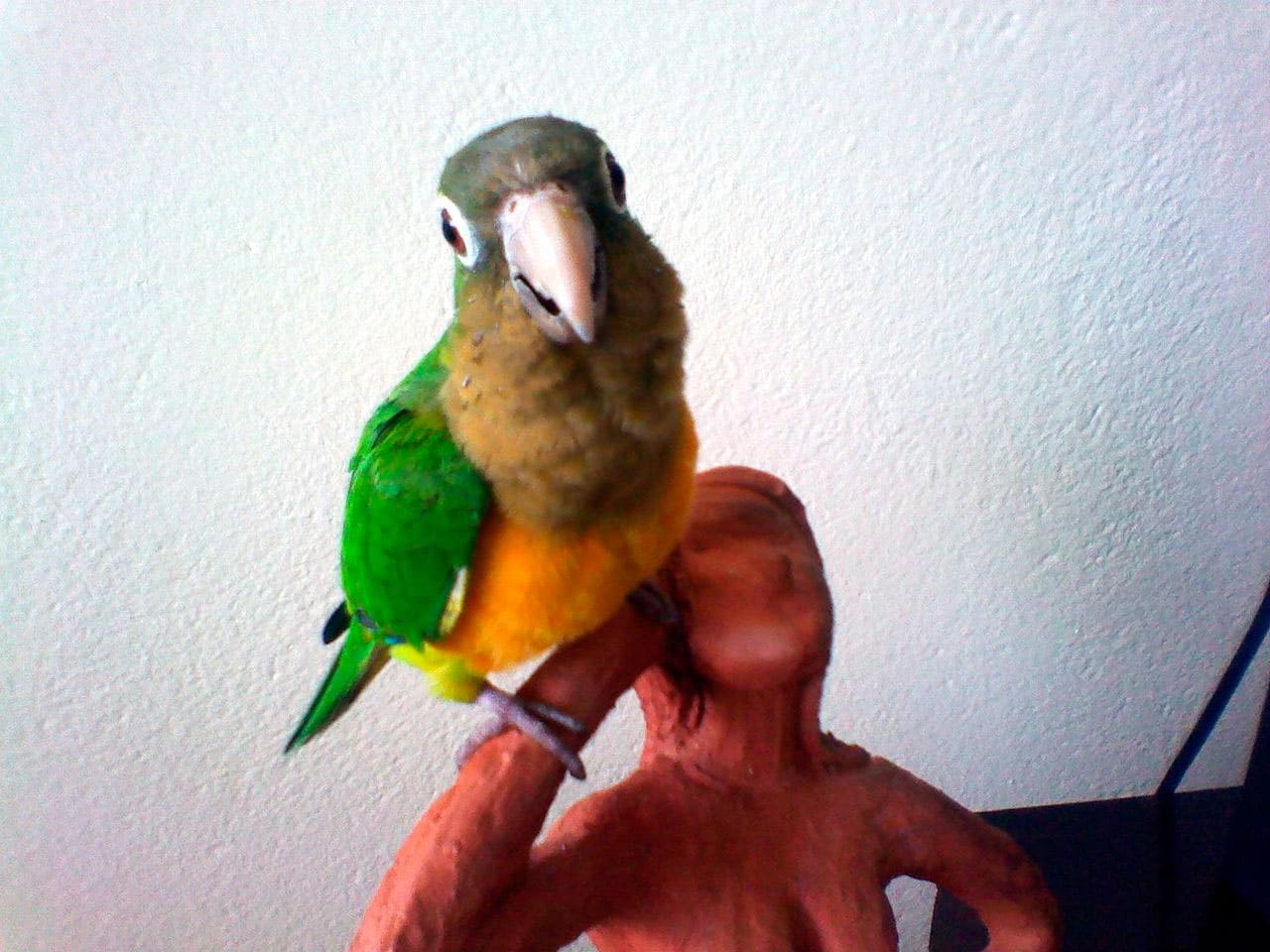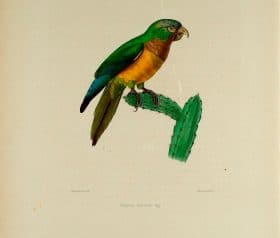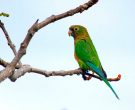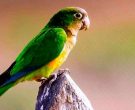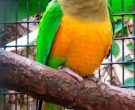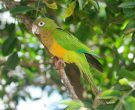Content |
|---|
Description:
25 cm.. length and 75-90 g. of weight.
The Cactus Parakeet (Eupsittula cactorum) has the forecrown, lores lower cheeks and brown off; crown with slaty tinge; sides neck, the nape and upperparts up to the rump grass-green.
The primary coverts They are bluish green in the outerweb, the remaining are green grass. Flight feathers (above) green on innerwebs, blue green on outerweb, blue black at the tips (below) gray. Underwing-coverts greenish yellow. Throat and upper breast dull brown; lower breast and belly fairly bright orange-yellow, the thighs and vent greenish-yellow color. Uppertail green, four distal blue central feathers; undertail gray.
upper jaw horn, greyish at base and lower jaw; perioftálmico patch naked white; irises brown-orange; gray-gray legs.
Both sexes similar. Immature paler than adult, with crown green, more olive upper chest and throat, and the irises darker.
- Sound of the Cactus Parakeet.
Subspecies description:
-
Eupsittula cactorum cactorum
(Kuhl, 1820) – Nominal.
-
Eupsittula cactorum caixana
(Spix, 1824) – Generally paler than nominal, with belly yellow instead of orange.
Habitat:
Video – "Cactus Parakeet" (Eupsittula cactorum) |
|---|
Its distribution area closely matches the dried vegetation and prickly caatinga Northeast Brazil, but it encompasses higher drier semi-desert areas created by overgrazing and dry forests (caatinga arborea) and seasonal savannah lusher (closed). Usually in pairs or (mainly outside the breeding season) flocks of up to 20 birds, most abundant where food is abundant (as rice crops).
Reproduction:
Crianza undocumented released. Clutch six eggs in captivity.
Food:
The diet includes seeds, fruits (including cactus), berries, dried fruits, flowers and cocoons, taken both trees and shrubs and soil. Sometimes it attacks crops (for example rice, grapes and corn).
Distribution and status:
Population expansion (breeding/resident): 1.220.000 km2
Distributed by the interior Northeast Brazil. The Cactus Parakeet extending from the drier parts of Bay and adjacent northeast Minas Gerais, Brazil north through Piauí and Southeast of maranhão, up to Pernambuco and Paraíba, passing by Rio Grande do Norte and Ceará. Absent in coastal areas: a record of Bethlehem at the mouth of amazon in For It seems wrong or possibly refers to a leak.
It is usually common (the most common parrot in some localities) with a stable population, although the decline is inevitable in some areas due to massive loss of habitat by agriculture and plantations of exotic trees. Continuing degradation and conversion caatinga by grazing and cultivation they represent a long-term threat. Present in the Serra da Capivara National Park. Any Local persecution due to predation crop. Atrapada to trade small numbers in captivity.
Subspecies distribution:
-
Eupsittula cactorum cactorum
(Kuhl, 1820) – Nominal. Bay to the South of St Francis River and adjacent portions of northeastern Minas Gerais, Brazil in the northeast of Brazil
-
Eupsittula cactorum caixana
(Spix, 1824) – Zone caatinga left of St Francis River from northwest Bay through Piauí and Pernambuco until Ceará and maranhão
Conservation:
State of conservation ⓘ |
||
|---|---|---|
 Minor Concern ⓘ
(UICN)ⓘ
Minor Concern ⓘ
(UICN)ⓘ
| ||
• Current category of the Red List of the UICN: Least concern.
• Population trend: Stable.
• Population size : Unknown.
Rationale for the Red List category
The trend population seems to be stable and, therefore, the species does not approach the thresholds for Vulnerable under the criterion of population trend (> 30% decrease in ten years or three generations). The population size has not been quantified, but it is not believed to approach the thresholds for Vulnerable under the criterion of population size (<10.000 mature individuals with an estimated> 10% continuous decline in ten years or three generations, or with a specific population structure). For these reasons, the species is evaluated as Least concern.
Justification of the population
The size of the world's population has not been quantified, but this species is described as “quite common” (Stotz et to the. (1996).
Justification trend
It is suspected that the population is stable the absence of evidence of any reduction or substantial threat.
Threats
Local persecution because of the invasion of crops. This species is also trapped for pet bird trade.
"Cactus Parakeet" in captivity:
Young birds are removed from their nest before they can fly, and then sold, for example, at the fair in inner cities.
These birds can become very tame, and it is not rare to see a Cactus Parakeet living “on freedom” in the owner's house, as a member of the family so to speak. It however is seeing a rare bird in captivity outside their range. It is not as common as other more familiar species of aratinga. It also, usually they reach very high prices.
The illegal trade It has greatly reduced the population of these Aratingas in nature, and threatens the survival of the species in many areas. Habitat destruction appears to be a minor problem.
For more information – Loro Parque
Alternative names:
– Caatinga Conure, Caatinga Parakeet, Cactus Conure, Cactus Parakeet (English).
– Conure des cactus, Perriche des cactus, Perruche des cactus (French).
– Kaktussittich (German).
– Aratinga-vaqueira, giguilim, Jandaia-gangarra, merequém, periquito-da-caatinga, periquito-gangarra (Portuguese).
– Aratinga Cactácea, Aratinga de los cactos, Periquito de los Cardones (español).
scientific classification:

– Order: Psittaciformes
– Family: Psittacidae
– Genus: Eupsittula
– Scientific name: Eupsittula cactorum
– Citation: (Kuhl, 1820)
– Protonimo: Psittacus cactorum
Images Cactus Parakeet:
Sources:
- Avibase
- Parrots of the World – Forshaw Joseph M
- Parrots A Guide to the Parrots of the World – Tony Juniper & Mike Parr
- Birdlife
-
Photos:
(1) – A pet Caatinga Parakeet in Riachão do Jacuípe, Baiano northeast, Brazil By Paulo Marcos from Painted-BA, Brazil (Periquito MartinsUploaded by snowmanradio) [CC BY 2.0], via Wikimedia Commons
(2) – Caatinga Parakeet (also known as Cactus Parakeet) in Brazil By Phillipe (Picasa Web Albums) [CC BY-SA 3.0], via Wikimedia Commons
(3) – Eupsittula cactorum – cactus conure – Cactus conure – conure cactus by Florin Feneru – Flickr
(4) – Parakeet CAATINGA (Eupsittula cactorum) by Cantosdanatureza WITH
(5) – Cactus Parakeet — aratinga cactacea by Animal Encyclopedia 2
(6) – Cactus parakeet – conographie parrots :.Paris :P. Bertrand,1857.. biodiversitylibrary.org/page/47804387
- Sounds: Robson Silva e Silva, XC248141. accessible www.xeno-canto.org/248141
